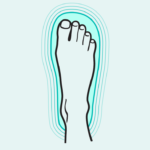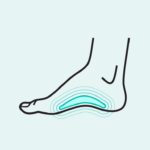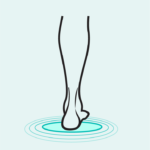Why Footwear Brands Are Investing in the Insole Experience
Footwear should be experienced – and footwear experience design trends include a thoughtful insole selection to ensure comfort, performance, and support.

With the number of options on the footwear market today, choosing a new pair of shoes should be simple, right? Unfortunately, not all footwear is designed with foot health in mind. As INSITE celebrates National Foot Health Awareness Month, here are five features to look for in your next pair of shoes to promote positive foot health and overall wellness.
 #1: Proper Fit
#1: Proper FitWe’ve all been there: you find what seems like the perfect pair of shoes, only to try them on and find the fit is just not right. You may feel tempted to buy them anyway and try to make them work. But, by doing so, you may be setting yourself up for a very uncomfortable experience down the road.
Proper fit is essential when choosing a new pair of shoes. There are several ways to tell if a shoe fits you well.
First, you should have enough space to wiggle your toes. There should be about a half-inch of space – or the width of a finger – between your big toe and the end of the shoe. This space helps to prevent your toe from bunching against the edge of your shoe while you walk.
Next, the back of the shoe should fit snugly against your heel. There should be no gap between your heel and the shoe. That way your shoe won’t slip up and down against your heel as you walk, helping to prevent blisters
Finally, the ball of your foot should be comfortable in the shoe. If your foot feels squeezed, you need to choose a wider width. Many brands offer a variety of widths to help you find the best fit.
 #2: Strong Arch Support
#2: Strong Arch Support For a shoe that promotes long-term comfort and relief, look for one with great arch support. A stable arch distributes pressure more evenly across the entire foot, rather than on the heels and balls of the feet. This can alleviate knee, hip, and back pain. It can also help to prevent injuries like plantar fasciitis, or inflammation of the tissue that connects the heel with the toes
Our research at INSITE has shown that arch support not only eases underfoot pressure, but it also assists the mechanics of the foot. As you’re choosing a new pair of shoes, look for a pair with great arch support to help you with a natural stride.
 #3: Extra Cushion in the Midsole or Insole
#3: Extra Cushion in the Midsole or Insole The midsole of a shoe is responsible for shock absorption. A thick midsole provides more cushion and limits stress on your body, which can reduce ankle and knee injuries. Insoles can provide even more cushioning and shock absorption where needed. A lighter, softer midsole can reduce pain from shin splints, while a heavier midsole can offer more support for plantar fasciitis. Either way, consider what you’ll be using the shoe for, and what you’ll need under your feet to keep you comfortable as you’re choosing a new pair of shoes.
 #4: Heel Stability
#4: Heel Stability For stability, look for a heel cup in the shoe’s insole. The insole should cup your heel and stabilize your foot. A heel cup promotes balance and reduces ankle overpronation, which is when the ankle leans too far inward. Overpronation can lead to the ankles, knees, and hips moving out of alignment. It can also cause pain and discomfort in the ankles, knees, hips, and lower back.
 #5: The Shoe Suits Your Lifestyle
#5: The Shoe Suits Your Lifestyle When choosing a new pair of shoes, consider the activities you’ll be doing while wearing them. For example, a basketball shoe will not suit the needs of a runner, and a running shoe will not suit the needs of a hiker. Different shoes offer different benefits based on the activity.
Some shoes have more ankle support. Others offer a more flexible midsole or better tread. Whatever your desired activity is, be sure you choose a shoe designed to fit your needs.

When it comes to footwear, looks aren’t everything. Our shoes affect how we move in the world, which in turn affects how we feel and what we can accomplish in our day. It all starts from the ground up.
Good foot health begins with the right pair of shoes. While many features can influence your footwear purchasing decision, these five points should be at the top of your checklist to ensure that your feet stay happy and healthy.
At INSITE, we use the science of biomechanics to make insoles that offer arch support, heel stability, and all-day comfort cushioning – all using the power of data. Look for footwear built with INSITE to help you make the best decision for your next pair of shoes.
Footwear should be experienced – and footwear experience design trends include a thoughtful insole selection to ensure comfort, performance, and support.
How do you strike a balance between sustainability and performance when it comes to footwear materials? INSITE® Director of Research & Design Justin Ter Har recently answered this question at the FDRA Sustainability & Innovation Summit in Portland, OR in September.
Orthotics have many benefits, and orthotic-inspired insoles allow footwear brands to deliver those benefits right out of the box.